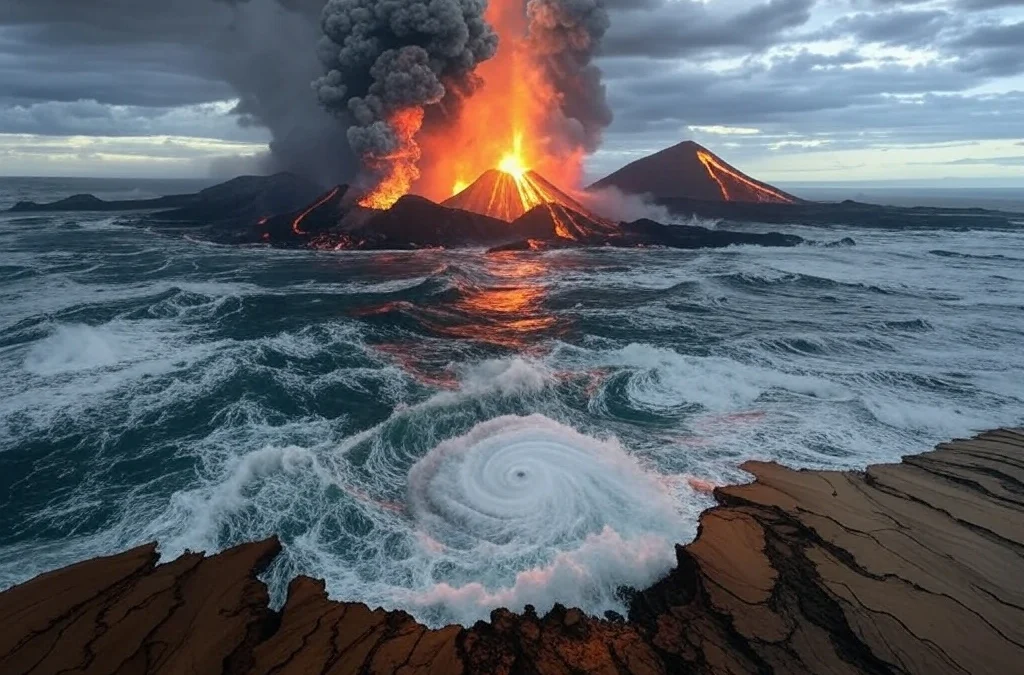Natural forces are the physical powers that operate throughout our universe, shaping everything from the tiniest atoms to the largest galaxies. These forces create order from chaos and drive the countless processes that make life on Earth possible. They are the invisible hands that guide the movement of planets, the flow of rivers, the growth of plants, and even the beating of our hearts.
From gravity pulling objects toward Earth to the electromagnetic forces that light our homes, natural forces are everywhere. While we might not always notice them, they are constantly at work, influencing every aspect of our daily lives and the world around us.
In this article we explore these remarkable forces, helping you understand what they are, how they work, and why they matter. Whether you’re a student, a curious mind, or someone looking to better grasp the world’s mechanics, this guide will shed light on the fascinating powers that govern our universe.
What Are Natural Forces?
Natural forces are the fundamental physical powers that act upon matter and energy throughout the universe. Unlike human-made forces (such as those produced by machines or technology), natural forces exist independently of human intervention and operate according to consistent, universal laws of physics.
These forces can be defined as any influence that causes an object with mass to accelerate or change its velocity. In simpler terms, a force is something that can push or pull on matter. Natural forces are responsible for all motion and change in the physical world, from the orbits of planets to the growth of living organisms.
The key characteristics of natural forces include:
- They operate according to specific, measurable physical laws
- They can act over distances (like gravity and magnetism)
- They can attract, repel, or transform matter and energy
- They exist at all scales, from subatomic particles to entire galaxies
- They cannot be created or destroyed, only redirected or transformed
Scientists have identified four fundamental forces in nature:
– gravity,
– electromagnetism,
– the strong nuclear force,
– the weak nuclear force.
These basic forces, along with their countless combinations and manifestations, account for all the natural phenomena we observe in the universe.
30 Examples of Natural Phenomena Driven by Forces
Natural forces can be seen all around us, from small everyday effects to powerful natural events. Below are 30 examples of natural phenomena driven by natural forces to help you understand how these forces work and why they matter in both nature and daily life.
1. Gravity
Gravity is the natural force that pulls objects toward Earth. It keeps your feet on the ground and causes apples to fall from trees.
2. Magnetism
Magnets attracting iron nails is magnetism in action. This natural force also guides compass needles north, helping travelers navigate.
3. Wind
Wind moves air around the globe. It can blow gently or fiercely, shaping landscapes by eroding rocks and sand dunes.
4. Earthquakes
Earthquakes occur when the Earth’s crust suddenly shifts. Buildings shake, roads crack, and sometimes entire cities can be affected by this powerful force.
5. Volcanic Eruptions
A volcanic eruption shoots hot lava and ash into the air. Volcanoes form mountains, islands, and even change weather patterns temporarily.
6. Ocean Tides
Tides are caused mainly by the gravitational pull of the moon. Fishermen and sailors rely on tides daily to navigate and fish safely.
7. Lightning
Lightning is electricity in the sky. It forms when charged particles in storm clouds rapidly discharge, creating bright, powerful bolts.
8. Solar Radiation
The sun sends solar radiation to Earth, heating the surface and making life possible. People experience this every day through sunlight warmth on their skin.
9. Erosion
Erosion happens when wind, water, or ice slowly wear down rocks and soil. This force gradually carves valleys and shapes mountains over time.
10. Tsunamis
Tsunamis are massive ocean waves triggered usually by underwater earthquakes. Their immense power can flood coasts, altering landscapes and lives.
11. Tornadoes
Tornadoes are rapidly spinning columns of air. They have enormous destructive potential, tearing down houses and uprooting trees in seconds.
12. Hurricanes
Hurricanes are huge, powerful storms forming over oceans. With strong winds and heavy rains, they dramatically reshape coastal areas.
13. Avalanches
An avalanche is a sudden rush of snow or ice down a mountain. Skiers and mountain climbers need to understand this force to stay safe.
14. Flooding
Flooding happens when rivers overflow, covering normally dry areas. This natural force can change entire towns overnight, affecting human lives dramatically.
15. Ocean Currents
Ocean currents are continuous flows of seawater that distribute heat globally. They affect climate and help sailors and fishermen navigate ocean waters.
16. Friction
Friction slows down motion. It stops cars when drivers apply brakes, and prevents shoes from slipping on sidewalks.
17. Thermal Expansion
When heat causes objects like metal rails or bridges to expand, that’s thermal expansion. Engineers carefully account for this force when designing structures.
18. Freezing and Thawing
Water expands when it freezes, breaking rocks apart. This freezing and thawing cycle gradually cracks sidewalks and roads each winter.
19. Centrifugal Force
When you spin a bucket of water quickly, centrifugal force keeps the water inside. This force also affects planets spinning around the sun.
20. Pressure
Pressure deep under oceans compresses objects dramatically. Deep-sea divers and submarines must withstand extreme pressure to explore safely.
21. Radioactive Decay
Radioactive decay is the breakdown of atoms. This natural force powers nuclear reactors and creates heat deep inside the Earth.
22. Corrosion
Rust forming on metal is corrosion. It’s a slow, persistent force that weakens structures like bridges, making regular maintenance essential.
23. Capillary Action
Capillary action helps plants absorb water. It causes liquids to move upwards in small tubes, essential for plant life and simple experiments.
24. Surface Tension
Surface tension allows insects like water striders to walk on water. It’s the natural force holding water molecules tightly together at surfaces.
25. Buoyancy
Buoyancy lets boats float on water. It pushes upward against gravity, determining whether objects sink or float.
26. Sound Waves
Sound travels as waves through air, water, or solids. Humans rely on this force daily for communication and understanding the environment around them.
27. Photosynthesis
Photosynthesis is how plants use sunlight to create food. This vital natural process powers nearly all ecosystems by creating energy from sunlight.
28. Electromagnetic Waves
Radio waves, microwaves, and X-rays are electromagnetic waves. People use them daily for communication, cooking, and medical imaging.
29. Geothermal Energy
Geothermal energy comes from heat deep inside Earth. People harness this natural force to heat homes and generate electricity in sustainable ways.
30. Meteor Impacts
Meteors striking Earth are a dramatic natural force. Large impacts historically reshaped climates and significantly influenced life on Earth.
Types of Natural Forces
Natural forces can be categorized in several ways, depending on how they act and where they operate. Understanding these categories helps us make sense of the diverse forces we encounter in nature.
Fundamental Forces
The four fundamental forces form the foundation of all physical interactions in the universe:
Gravitational Force: The attraction between objects with mass. It’s the weakest fundamental force but acts over infinite distances.
Electromagnetic Force: Governs the interaction between electrically charged particles. This force is responsible for electricity, magnetism, and light.
Strong Nuclear Force: The most powerful force in nature, it holds protons and neutrons together in atomic nuclei.
Weak Nuclear Force: Responsible for radioactive decay and nuclear fusion in stars.
Contact vs. Non-Contact Forces
Contact Forces require physical touch between objects:
- Friction
- Normal force (the push between surfaces in contact)
- Tension
- Applied force (direct pushing or pulling)
Non-Contact Forces act across space:
- Gravity
- Magnetism
- Electrical forces
Macroscopic vs. Microscopic Forces
Macroscopic Forces operate at scales we can directly observe:
- Wind
- Water pressure
- Tectonic forces
Microscopic Forces work at the atomic or subatomic level:
- Chemical bonds
- Nuclear forces
- Quantum interactions
Read also: 100 Natural Things List
The Impact of Natural Forces on Earth
Natural forces shape our planet in countless ways, creating both spectacular and subtle changes in Earth’s systems.
Geological Impacts
The planet’s surface is constantly being reshaped by natural forces. Tectonic forces drive the movement of continental plates, leading to earthquakes, volcanic eruptions, and mountain formation. Over millions of years, these slow but powerful movements have created the landscape we know today.
Erosion forces, powered by gravity, water, and wind, wear down mountains and carve valleys. Rivers transport sediment to form deltas and floodplains. Glaciers grind down rock and deposit materials as they move, sculpting distinctive landforms.
Weather and Climate
The atmosphere is a dynamic system driven by multiple natural forces. Solar radiation heats the Earth unevenly, creating temperature differences that drive wind patterns. The planet’s rotation adds complexity to these movements through the Coriolis effect.
Water undergoes continuous cycling through evaporation, condensation, and precipitation, powered by solar energy and gravity. This hydrological cycle transfers heat energy around the globe and provides the freshwater essential for life.
Biological Systems
Living organisms have evolved to work with natural forces rather than against them. Plants grow upward against gravity using specialized cellular structures. Birds and insects use aerodynamic forces to achieve flight. Marine creatures harness water pressure and buoyancy to move through their environment.
Even at the cellular level, natural forces govern critical processes. Osmotic pressure drives the movement of nutrients across cell membranes. Electrical forces control nerve signals in animals. Enzyme reactions depend on the electromagnetic forces between molecules.
Natural Forces in Everyday Life
Though we rarely think about them, natural forces affect almost everything we do. Understanding these everyday interactions can give us a new appreciation for the physics that surrounds us.
When you walk, you’re engaging in a complex dance with friction and gravity. Friction between your shoes and the ground prevents you from slipping, while gravity pulls you toward Earth’s center. Your muscles work against gravity with each step, and momentum carries you forward.
At home, natural forces are equally present. The weight of your furniture on the floor is gravitational force balanced by the normal force pushing back. When you turn on a light switch, you’re harnessing electromagnetic forces to move electrons through wires. The water pressure in your shower comes from gravitational potential energy.
Even cooking involves natural forces: heat transfer through conduction, convection, and radiation cooks your food. The boiling of water happens when thermal energy overcomes the attractive forces between water molecules.
Sports offer particularly clear examples of natural forces in action. A baseball’s curved path demonstrates both gravity and air resistance. A swimmer pushes against water, using Newton’s Third Law of Motion. The bounce of a basketball shows the conversion of potential energy to kinetic energy and back again.
How Scientists Measure Natural Forces
Scientists have developed various methods and tools to quantify natural forces, allowing us to understand and predict their behavior.
Units and Measurements
The standard unit for measuring force is the newton (N), named after Sir Isaac Newton. One newton is the force required to accelerate a one-kilogram mass at a rate of one meter per second squared.
Other related measurements include:
- Pressure: Force per unit area (measured in pascals)
- Torque: Rotational force (measured in newton-meters)
- Work: Force multiplied by distance (measured in joules)
Measuring Instruments
Different forces require different measurement tools:
For Gravity: Gravimeters detect tiny variations in gravitational fields by measuring how they affect the position of a suspended mass.
For Electromagnetic Forces: Voltmeters, ammeters, and magnetometers measure different aspects of electromagnetic fields and currents.
For Mechanical Forces: Load cells, strain gauges, and dynamometers directly measure pushing or pulling forces.
For Weather Forces: Barometers measure atmospheric pressure, while anemometers track wind force and direction.
Modern scientific laboratories often use highly sophisticated equipment to measure forces at extreme scales, from the interactions between subatomic particles to the gravitational waves produced by colliding black holes billions of light-years away.
Natural Forces and Modern Technology
Much of today’s technology works by harnessing, redirecting, or countering natural forces in clever ways.
Energy Generation
Nearly all our energy production methods involve converting natural forces into usable electricity:
- Hydroelectric dams use gravity acting on falling water
- Wind turbines capture kinetic energy from moving air
- Solar panels convert electromagnetic radiation into electrical current
- Nuclear power plants harness the strong and weak nuclear forces
Transportation
Vehicles must work with or against multiple natural forces:
- Airplanes generate lift to overcome gravity
- Boats use buoyancy to float and propellers to counter water resistance
- Cars rely on friction between tires and road for acceleration and braking
- Rockets must generate enormous thrust to escape Earth’s gravitational pull
Communications Technology
Wireless communication depends entirely on controlling electromagnetic forces. Radio waves, microwaves, and other forms of electromagnetic radiation carry our phone calls, internet data, and broadcast signals through space.
Medicine and Healthcare
Medical technologies often involve precise measurements and applications of natural forces:
- MRI machines use strong magnetic fields to create detailed body images
- Radiation therapy directs carefully controlled electromagnetic energy at cancer cells
- Physical therapy equipment uses resistance forces to strengthen muscles
- Surgical tools apply precisely calibrated mechanical forces
As our understanding of natural forces continues to grow, so too will our ability to develop new technologies that improve human life while working in harmony with nature’s fundamental principles.
Frequently Asked Questions About Natural Forces
How do natural forces differ from artificial forces?
Natural forces exist independently of human activity and follow consistent physical laws. Artificial forces are those generated through human technology or intervention. For example, gravity is a natural force, while the thrust from a rocket engine is artificial. However, artificial forces still operate according to the same physical laws as natural forces.
Can natural forces be created or destroyed?
According to the law of conservation of energy, forces cannot be created or destroyed, only transformed from one form to another. For instance, when water flows downhill due to gravity, some of that gravitational potential energy converts to kinetic energy (motion) and eventually to heat through friction.
Which natural force is the strongest?
The strong nuclear force is by far the most powerful of the four fundamental forces, approximately 100 times stronger than the electromagnetic force, 10^13 times stronger than the weak nuclear force, and 10^38 times stronger than gravity. However, it only operates over extremely short distances within atomic nuclei.
Why don’t we feel most natural forces?
We’re constantly affected by numerous natural forces, but we often don’t notice them because:
- Our bodies have adapted to them (like Earth’s gravity)
- Some forces operate at scales too small for us to detect (like nuclear forces)
- Many forces reach equilibrium in everyday situations
- Our senses evolved to detect changes rather than constants
How do natural forces relate to energy?
Forces and energy are closely connected but distinct concepts. Forces cause objects to accelerate or change direction, while energy is the capacity to do work. When a force moves an object, it transfers energy to that object. Different types of energy (kinetic, potential, thermal, etc.) often result from the action of different natural forces.
Conclusion
Natural forces are the invisible but powerful influences that shape our universe at every level. From the majestic spiral of galaxies to the delicate structure of a snowflake, these forces create both order and change throughout the cosmos.
As we’ve seen, natural forces are not abstract concepts relevant only to physicists and engineers. They touch every aspect of our lives, from the simple act of walking to the complex technologies that power our modern world. By understanding these forces, we gain insight into how our world works and how we might better live within it.
Scientists continue to deepen our knowledge of natural forces, especially at the extremes of scale—the unimaginably small quantum realm and the inconceivably vast cosmic structures. Each discovery opens new possibilities for technology and expands our appreciation for nature’s elegant design.
The next time you feel the wind on your face, watch waves crash on a shore, or simply stand firmly on the ground, take a moment to appreciate the remarkable natural forces at work.
Read also: 40 Natural Resources Examples & Their Uses
The Most Popular on BitGlint

Top 100 Personal Items List
Everyone uses personal items in their daily lives, often without even thinking about them. From the moment you wake up...

30 Defiance Examples & Meaning
Defiance is something most people experience at some point in life. You feel it when you say no to something that...

Top 30 Desire Examples & Definition
Desire is a powerful force that drives much of human behavior, shaping our goals, dreams, and everyday decisions. It's...

100 Non-Digital Things List
In everyday life, there are still hundreds of objects, tools, and materials that exist completely outside the digital...

30 Examples of Attention & Definition
Have you ever noticed how a catchy tune can grab your attention, even when you're busy doing something else? It's...

60 Cultural Traditions Examples & Definition
Cultural traditions are part of daily life - whether people realize it or not. They shape what we eat, how we...

Top 30 Intimacy Examples & Meaning
Intimacy goes beyond physical touch or romantic moments. It’s about closeness, trust, and connection. In everyday...
Get Inspired with BitGlint
The Latest
40 Emotional Value Examples & Meaning
Why do some messages stick — while others are forgotten? Why do people choose one brand over another, even when the product is the same? The answer often comes down to emotional value. Emotional value is what makes a message feel human. It’s the emotional connection...

30 Teasing Examples & Definition
Teasing is a common part of human interaction. People tease in different ways, for different reasons. Sometimes it is friendly. Sometimes it can hurt feelings. Understanding what teasing means and seeing clear examples helps everyone handle these moments better....
40 Thought Experiments for Curious Minds
Some questions can’t be answered with a simple yes or no. Some problems don’t have a clear solution. That’s where thought experiments come in. They aren’t just old ideas from philosophy books. Thought experiments are tools we still use to think through problems, test...
Technology vs Information Technology
Technology is a broad term that refers to the use of scientific knowledge, tools, machines, and systems to solve problems and improve human life. It includes everything from simple tools like hammers to advanced innovations like artificial intelligence and space...

